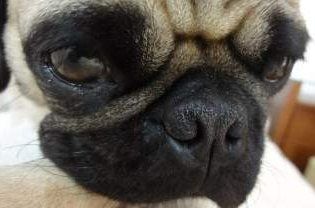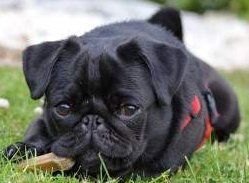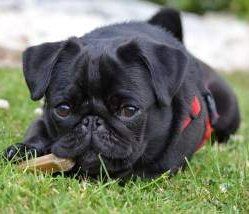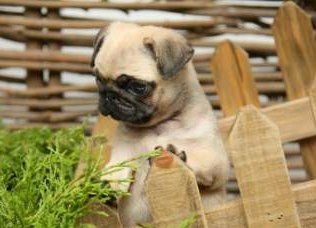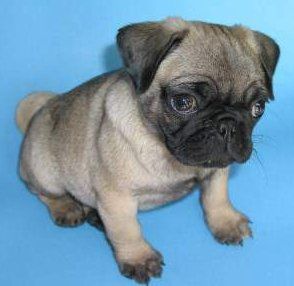Pug Puppy Care

The Pug is the largest of all toy breeds, one of the most unique looking and certainly a breed that requires specific care to stay happy and healthy.
Overview
When you have a dog from the age of a young pup, this gives you a wonderful opportunity. It offers you a chance to bond with your dog from the very beginning. This also gives you an advantage because you will be able to train and teach your pup what they need to know before they learn any bad behavior from elsewhere.
This section will discuss how to care for a Pug puppy, starting at 8 weeks old and up until he or she is an adult, at the age of 1 year.
Transition to a New Home
Things will run much smoother if you plan ahead and have most, if not all, of your puppy care items already in your home. Here are the most important items to have:
A crate –
One with an adjustable size is best to fit the needs of a growing Pug puppy. Crating is a good night time method to use until a pup is housebroken.
Gates or a playpen –
Choosing an area to gate off or using a canine playpen
are good options for when you must leave your Pug puppy home alone or for when you cannot be right at his side. This keeps the pup in a controlled space which helps in regard to bathroom needs and keeping a puppy in one area when he or she has strong chewing urges.
Puppy food –
This should be obtained before the puppy is brought home. Owners will not always agree with the food that a puppy has been being fed, however any change should be done gradually. Have the food that the Pug has been used to eating on hand, as well as your new choice.
Details regarding making this change can be found here: Feeding a Pug.
As for the type of dishes to use, the best bowls for this breed
are stainless steel (ceramic can be okay as well, but can crack or shatter), since plastic bowls can leak coloring which can cause allergic reactions and/or staining of the facial fur. You'll also want them to be sized appropriately and at floor level.
Honey –
Puppies are prone to the condition of hypoglycemia, which is a rapid and dangerous drop in blood sugar levels.
Stress, among other things, can bring this on and while going to a new home is a happy event, it can also be stressful for a little pup that is leaving all that he knew and no longer has the companionship and friendship of his litter-mates.
Signs of hypoglycemia are: weakness, sudden sleepiness, dizziness, stumbling when walking and/or confusion. Treatment can be provided at home as plans are being made to bring the puppy to the closest animal hospital or veterinarian.
A small dab of honey is rubbed onto the gums and then the puppy should receive professional treatment, sometimes an IV to restore sugar levels back to normal.
Leash, collar and harness –
Pugs are prone to conditions that involve breathing problems. The body structure of this breed confines breathing passages into a small space and Pugs can have smaller than normal nasal passages and openings (stenotic nares). For this reason, using a harness can help a Pug breathe easier when on leash. A short 6 foot leash works best for both potty training and heeling. Read more :Choosing the Best Collar and Harness for a Pug
Grooming supplies – The thick coat of a Pug sheds heavily and brushing it well and offering baths on a regular basis can help control shedding. Starting dental care at a young age can help a puppy become used to this grooming element and set up a foundation for a life time of good dental hygiene practices. Keeping the wrinkles, eyes and ears clean are important part of caring for a Pug puppy.
Read more:
Shedding - Expect your Pug to shed a lot and be prepared by having the right tools.
Dental care - Taking care of your Pug's teeth should be high on your priority list.
Ears - Expected shapes and proper care.
Wrinkles - Keeping the wrinkles dry and clean.
Sleeping supplies - Some owners prefer to have their puppy sleep in the bed with them and while this is not always a bad thing, an owner should think about how that will play out as the pup matures into a much larger adult dog. Puppies develop habits quickly and once a Pug gets used to a human’s bed, he may be very reluctant to make a change. Having a pup get used to his own canine bed from the beginning, set up in a quiet corner of a room, may work out best.
Do keep in mind that Pugs crave human companionship and do not like to feel isolated. Setting up the bed in a quiet corner of a well-used room allows a Pug to have a nice area to retreat to for rest and sleep while allowing him to be close to his human family. It will be normal for a little one to sleep anywhere from 16 to 18 hours a day...This included both night time sleep and naps that will be taken throughout the day.
Chew Toys –
Teething will begin around the age of 3 or 4 months old and can last up until a Pug puppy is 8 months old. Having a good supply of toys on hand for a puppy to chew on is important.
Puppy Proofing
Before bringing a puppy home and on a regular basis (at least weekly) owners are encouraged to go over all floors to remove any small objects that could be accidentally swallowed. All items that could be chewed on such as pocket books and shoes should be placed up high until the Pug has matured.
Whining
It is normal for very young puppies to cry when first brought to a new home, this usually only lasts for a week or so as the pup becomes used to his new family and environment. This can also be a sign of needing to go to the bathroom, so following house training guidelines, be sure to take your Pug puppy outside on a regular basis.
Vaccinations for the Pug Puppy
An important part of caring for your puppy will be to make sure he or she is up-to-date for all needed vaccinations. An 8-week-old should already have received his shots, as well as a de-worming. Veterinarians will have varying schedules, however this is a general guideline:
5 weeks
Parvovirus: For puppies at high risk of exposure to parvo, some veterinarians recommend vaccinating at 5 weeks.
6 weeks
• Combination vaccine*
without leptospirosis (this is only included where leptospirosis is a concern). Dogs at high risk are those that live in areas where wild life (raccoon, skunk, deer, etc.) has access to the areas that pup frequents for outside play and/or bathroom needs.
• Coronavirus: where coronavirus is a concern.
9 weeks
• Combination vaccine* without leptospirosis.
• Coronavirus: where coronavirus is a concern.
12 weeks or older
• Rabies: Age at vaccination may vary according to your local laws
12-16 weeks
• **
Combination vaccine
• Leptospirosis: Include leptosporosis in the combination vaccine where leptospirosis is a concern, or if traveling to an area where it occurs.
• Coronavirus: where coronavirus is a concern.
• Lyme: where Lyme disease is a concern or if traveling to an area where it occurs.
Adult
***(boosters)
• Combination vaccine
• Leptospirosis: include leptospirosis in the combination vaccine where leptospirosis is a concern, or if traveling to an area where it occurs.
• Coronavirus: where coronavirus is a concern.
• Lyme: where Lyme disease is a concern or if traveling to an area where it occurs.
• Rabies: Given by your local veterinarian (time interval between vaccinations may vary according to local law).
*A combination vaccine, often called a 5-way vaccine, usually includes adenovirus cough and hepatitis, distemper, parainfluenza, and parvovirus. Some combination vaccines may also include leptospirosis (7-way vaccines) and/or coronavirus. The inclusion of either canine adenovirus-1 or adenovirus-2 in a vaccine will protect against both adenovirus cough and hepatitis; adenovirus-2 is highly preferred.
**Some puppies may need additional vaccinations against parvovirus after 15 weeks of age. You will want to talk to your veterinarian about this.
Reactions to Vaccines
Immunizations are intended to stimulate the immune system to then protect a dog against a specific infectious disease. It is very important to have your Pug receive all needed vaccinations. However, this stimulation of the dog’s immune system may cause some minor symptoms. Your Pug may react to immunizations in ways that range from soreness at the site of injection to mild fever to allergic reactions. The allergic reactions can range from mild to severe.
Mild-
Mild reactions include fever, sluggishness, and loss of appetite. Mild reactions usually resolve without any treatment needed.
Moderate -
The dog’s skin may show a reaction. This is called Urticaria. This happens when there is a reaction of the skin and shows as hives or bumps. There can also be swelling that happens very quickly, redness on the dog’s lips, around the eyes and in the neck region. It is usually extremely itchy. Urticaria may progress to anaphylaxis, which is considered life-threatening. However, Urticaria is the most common reaction in dogs if a reaction is to happen.
Severe -
The most severe reaction is anaphylaxis. This is a very fast, sudden, severe allergic response that causes breathing difficulties, collapse and possible death. This is very rare.
Urticaria (the moderate and most common reaction, if one is to occur) happens soon after vaccination, often even before the puppy is brought home. It can happen in the car while you are driving back to your house. Your veterinarian will recommend immediate return to the hospital for treatment.
Urticaria is usually treated successfully with injectable corticosteroids like dexamethasone or prednisone. Antihistamines do little to help with acute allergic reactions but may be given by injection to help prevent recurrence of symptoms after steroids wear off.
Mild vaccination reactions usually require no treatment. However, if the symptoms persist for more than 24 hours, call your veterinarian.
Growth Rate
A Pug puppy grows quickly and this can happen gradually or with spurts and stops. Many Pug puppies have a growth spurt near the 3 to 5 month mark. As the pup nears the 1 year mark, growth will slow down. Once a Pug reaches his or her full height, there may still be some growth in the width of the Pug, as the chest widens and fills out. How a Pug ages and his growth
is rapid, yet can be staggered during the first year.
Getting Your Puppy Comfortable
One of the most important parts of bringing a puppy home is allowing him or her to become used to their new surroundings.
Allow your pup to roam around and check out his new environment. Be sure to keep a puppy's water
in one designed spot so that the pup can know that it can always be found. The drinking and feeding area should be in a quite corner of a room, without much foot traffic or noise, since small puppies can feel vulnerable while eating.
Puddles, Piddles & Messes
Your Pug puppy will have almost no control over their bladder when they are very young and housebreaking is one of the most important care elements, since proper training will instill a life time of good habits.
The absolute longest that a 2 month old pup can hold their needs is 2 hours. The bladder and bowel muscles are not yet fully developed. As they grow older, this time will increase as they have more control over their body.
Usually it will increase by 1 hour for each month that goes by. Therefore, a 3 month old can hold on for about 3 hours, a 4 month old for about 4 hours and so on...With 8 hours being the maximum time for any age.
You should take your puppy outside at the following time (and any time that he/she makes a motion to 'go'):
- When he first wakes up in the morning
- About 20 minutes after each of his 3 meals
- After every nap time
- Before bedtime
- Every 2 hours (or 3 or 4- see above) if not taken out for the other above reasons.
Informational Note:
When your 2 month old needs to go outside at least every 2 hours, be sure to not get stuck into that habit...It is important to slowly increase the time intervals. Your 3 month old can wait about 3 hours, but only if you allow the pup to use his bowel and bladder muscles to work and grow stronger.
If an owner always brought their Pug outside every 2 hours, the dog would never learn to hold their needs for a longer period of time. Keep reading
about the best way to house train a Pug puppy.
Your Pug Puppy and Other Dogs
Pug puppy care guidelines will tell you to keep him or her away from any strange dogs; you will have no way of knowing if a dog that is unknown to you is up-to-date on all of their shots and/or carrying a disease.
All puppy vaccinations should be given before you take him or her out to the park, to pet supply stores or any other area in which there may have been or could be other animals.
Many new owners already have another dog in the household. In cases such as this, if you are 100% confident that your current dog is up-to-date on all shots and is disease free, there is no reason to keep your new puppy away from your other dog.
As your puppy grows older and is receiving the needed vaccinations, you can slowly begin introducing your new puppy to other dogs and allow normal socialization to begin.
The Necessities of Care
To have a healthy and happy puppy that will grow into a happy and healthy adult dog, make sure to always provide the essentials:
- A proper diet. You will need to decide if you want to offer manufacture food, home cooked food or a combination of both.
- The right amount of exercise
- A good grooming routine
- Always keep veterinarian appointments for needed vaccinations and frequent checkups
- Never think that your Pug is immune to the possibility of heartworms - preventive medication is a must
- Keep an eye out for health problems
- Always return affection & love...Pugs are very sensitive to their human's emotions. A hug goes a long way!


